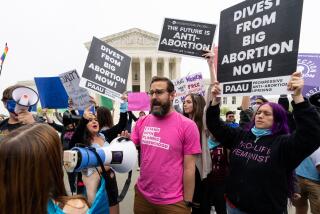Public Funding for Family Planning Drops : Clinics: Support fell by a third in 1980s as health problems worsened, studies show.
In a decade that saw the emergence of AIDS, reduced access to abortion and a rise in unintended childbearing, public funding for family planning dropped by one-third in inflation-adjusted dollars during the 1980s, a new study has found.
The study, released Thursday, documents for the first time the decade-long decline in support for clinics relied upon by millions of U.S. women.
Meanwhile, a separate study found that family-planning clinic patients have more health problems than in the past and often no other source of medical care. And rising costs of Pap smears and oral contraceptives have been driving up overall clinic costs.
“Family-planning clinics are being asked to do more and more and more and to do it with less and less and less,” said Rachel Benson Gold of the Alan Guttmacher Institute, the New York City-based, reproductive-health think tank that conducted both studies.
“Fewer women will have access to the services they need to prevent unintended pregnancies and to prevent and treat sexually transmitted diseases,” Gold said. The principal reason for the federal and state funding trend was the decline in inflation-adjusted dollars in funding for Title X, the Public Health Service Act program that has long been central to the national family-planning effort.
Congress has failed to reauthorize Title X since 1985 because of a series of controversies over family-planning services and abortion. Though yearly stopgap funding measures have kept the program alive, it has not kept pace with inflation, Gold found.
“There are so many consequences,” said Marie Paris, a spokeswoman for Planned Parenthood of Los Angeles. “There’s the human cost, the public health cost. . . . “
The long-term consequences of inadequate family-planning services could range from a dangerous ignorance among teen-agers on matters of sexuality to unwanted pregnancies, pregnancy complications and infertility from untreated sexually transmitted diseases, clinic supporters say.
In the first of the two studies, to be published shortly in the institute’s journal, Family Planning Perspectives, Gold and Daniel Daley found that spending rose from $350 million in 1980 to $504 million in 1990--the equivalent of a decline to $232 million in 1980 dollars.
The proportion of public family-planning expenditures contributed by Title X dropped by nearly half, Gold and Daley found. Taking inflation into account, Title X expenditures for contraceptive services have fallen by almost two-thirds since 1980.
Many state governments apparently attempted to offset the drop in federal money, the researchers found. The number of states contributing their own family-planning funds rose from 25 to 44, but Gold and Daley found that the states were unable to make up the loss.
At the same time, clinics faced growing financial and medical burdens. A study of more than 50 clinics by Patricia Donovan, senior associate for law and public policy at the Alan Guttmacher Institute, found that the proportion of patients needing screening and treatment for sexually transmitted diseases “increased dramatically.”
From 10% to 15% of the clients in certain clinics needed screening or treatment for chlamydia alone, Donovan was told.
At the same time, certain clinic costs soared. The laboratory charge for a Pap smear rose from $2.75 to $10 between August, 1990, and January, 1991, for most clinics funded through the Colorado Health Department--a pattern seen nationally after recent federal legislation tightening regulation of clinical labs.
More to Read
Sign up for Essential California
The most important California stories and recommendations in your inbox every morning.
You may occasionally receive promotional content from the Los Angeles Times.










